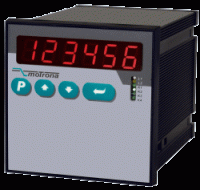SIL3/PLe certified Safety Monitor for Speed, Standstill and Direction of rotation
(for connection of a SIL3/PLe certified SinCos encoder or sensor) |
DS 240*: (1 relay, 4 control outputs push-pull, analogue output, signal splitter)
DS 246*: (1 relay, 4 control outputs push-pull, analogue output)
BG 230*: Display- and programming module (optional) | |
SIL3 and PLe certificationSafety functions equivalent to EN61800-5-2 (SS1, SS2, SOS, SLS, SDI, SSM)Suitable for the connection with SIL3/PLe certificated Sine-Cosine sensors orSinCos encoders with 1 Vpp (format sin+, sin-, cos+, cos-)Two inverse redundant HTL / PNP inputs for encoders, proximity switches and control commands (10 – 30V)Extremely large bandwidth of 500 kHzForced guided redundant output relay (NO). Beside device errors, more alarm states can freely be parameterized (over- and under-speed, direction of rotation, standstill)The function of the four inverse redundant digital outputs is also free programmableSafe analogue output with 4 – 20 mA for transmitting of proportional control loop valuesEasy and safe integration into existing sensor wirings enabled by the integrated signal splitterFast and intuitive parameter setup by using the free service software or by using the programming module (optional)Snap-on module for standard DIN rails (35 mm C-profile)
| 
|
______________________________________________________________________ |
SIL3/PLe certified Safety Monitor for Speed, Standstill and Direction of rotation equipped
with multi functional inputs
(redundancy due to free combinations of SinCos-, Incremental- and HTL- encoders or sensors) |
DS 230*: (1 relay, 4 control outputs push-pull, analogue output, signal splitter)
DS 236*: (1 relay, 4 control outputs push-pull, analogue output)
BG 230*: Display- and programming module (optional) | |
The model range DS230 – DS236 is equivalent in function to the devices DS240 – DS246 (described above), except of the sensor inputsFurthermore these types are suitable for the connection of incremental encoders or sensors with RS422 output (differential signals A, /A, B, /B)Free combinable with Sine-Cosine sensors or SinCos encoders with 1 Vpp (format sin+, sin-, cos+, cos-)Redundancy can also be achieved by HTL encoders or proximity switches
| 
|
______________________________________________________________________ |
Universal Monitor / Controller for Speed, Standstill, Direction
(suitable for incremental encoders and sensors) | |
DZ 260*: (3 relays, serial RS232 interface and analogue output)
DZ 261*: (3 fast switching transistor outputs, RS232 and analogue output)
DZ 267*: (3 relays, serial RS232 interface)
DZ 269*: (3 fast switching transistor outputs, serial RS232 interface) | |
Most versatile and fast-responding speed monitors for control and monitoring of overspeed, underspeed, standstill and direction of rotationImpulse inputs for use with single channel signals (A only) or quadrature signals (A, B, 2×90°) or TTL- and RS422-signals with differential formatA, /A, B, /BWide operating range from 0.1 Hz to 1 MHzParameter settings by 4 front keys and LCD menuSerial RS232 interfacePower supply 24 VdcAuxiliary +5V output for supply of TTL encodersHousing for panel or DIN rail mounting
| |
______________________________________________________________________ |
| | |
| | |
| | |
| |
| |
DZ 210*: Simple Monitor for Standstill and Direction of Rotation | |
Simple industrial monitor and controller for control of clockwise oranti-clockwise rotation and standstillVersatile impulse inputs for operation with all common incremental encoders and sensorsHigh maximum input frequency (500 kHz) and very fast response time(<1 msec. with f >1 kHz)Two output relays (dry change-over) and two fast-responding transistor outputs
| |
______________________________________________________________________ |
ZD 640: Industrial Controller and Monitor for
Slip, Skew Position, Torsion, Shaft Fracture | |
Industrial Monitor with inputs for two independent incremental encoders, each A/B (2×90°) or A, /A, B, /B (RS422 or TTL)The unit forms the difference between both encoder positions and compares the result (including sign) with four programmable preset valuesFour output relays indicate the state of the actual position errorSelectable Reset functions under timer control also allow monitoring of nominal slip, with alarm outputs when exceeding slip preset limits Example: Monitoring of shaft torsion and gear backlash
| |
______________________________________________________________________ |
MS 640: Universal Motion Monitor for Safe and Redundant Monitoring of Motion
(speed, position, direction, motion aberration etc.) | |
Programmable monitor, designed for monitoring and controlling of admissible and impermissible operating conditions on machinery systems.This unit is not just a speed monitor, but provides comparison between peripheral motion, motor motion and scheduled demand values of the control system.2 separate encoder inputs, 4 control inputs and 6 logical inputs for pick-up of motion and peripheral eventsContinuous measuring and evaluation of all actual values of both encoders (actual speed, direction of rotation, motion or standstill, actual position, differential position)4 fast switching transistor outputs and 4 forced-guided relay outputs, all with safety monitoring by internal feedbackEasy PC setup of the the desired monitoring functions and the output switching conditionsExtensive peripheral safety by detection of external problems(mechanical, sensors, cables etc.)High functional safety by extensive self tests for detection of internal failures, breakdown of components, malfunction etc,
| |










